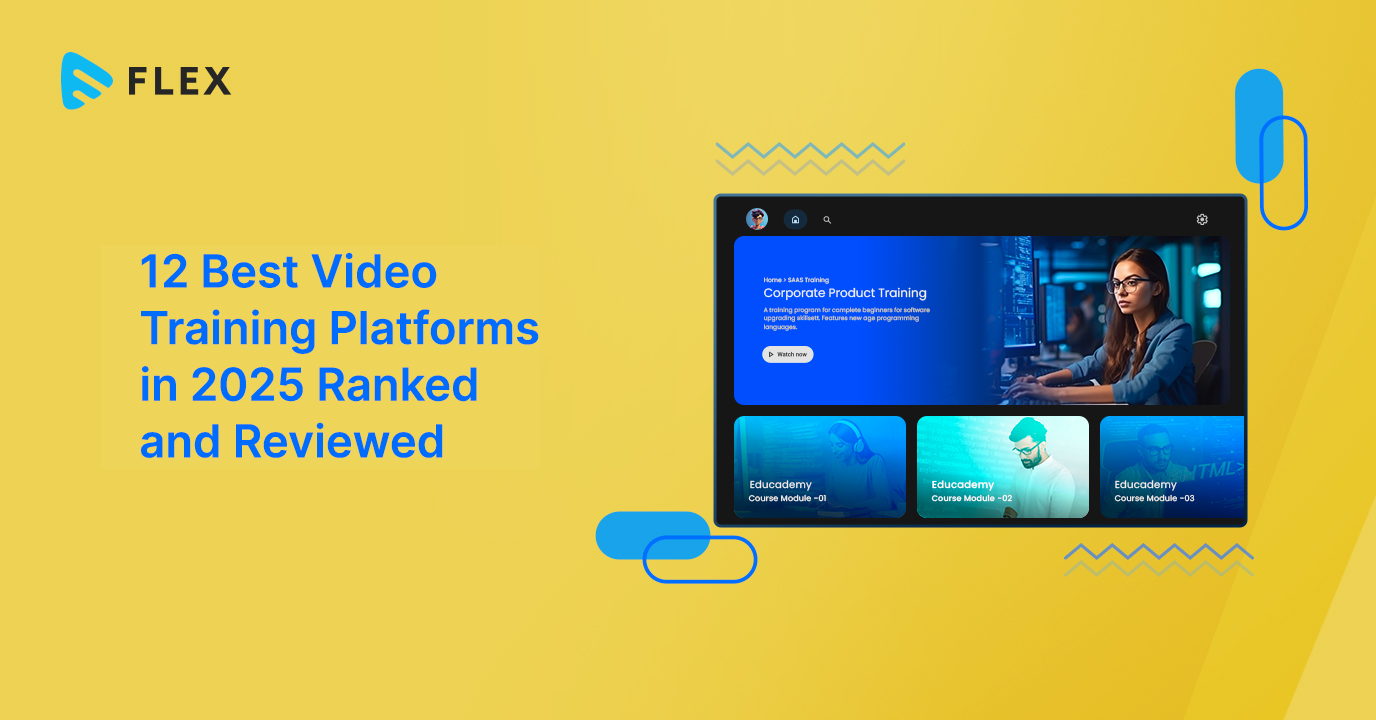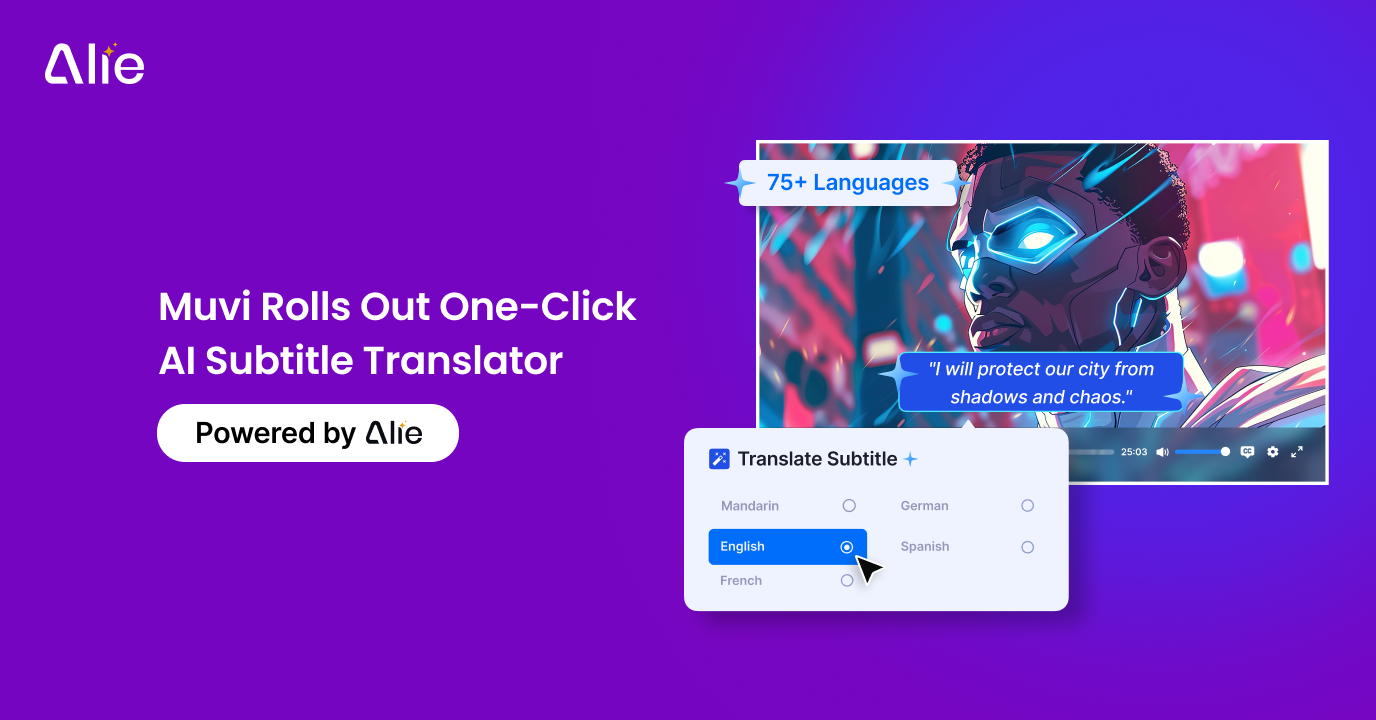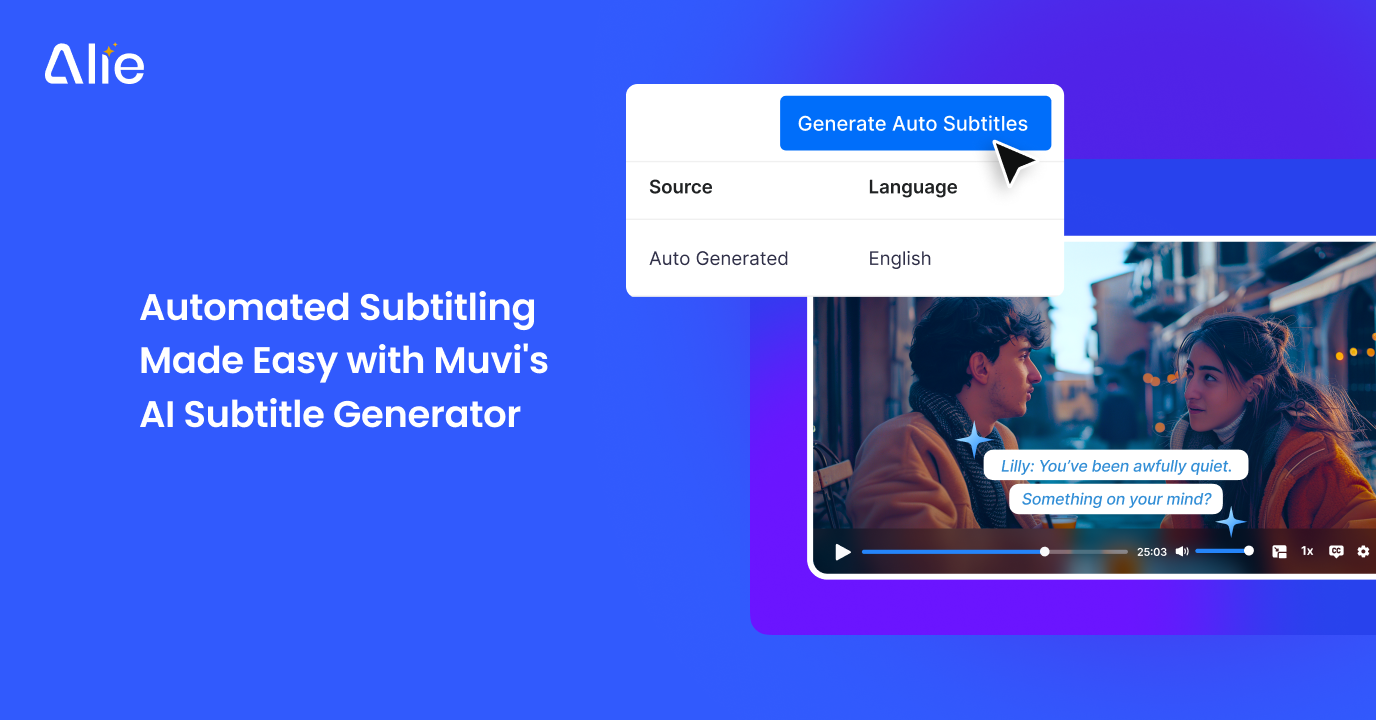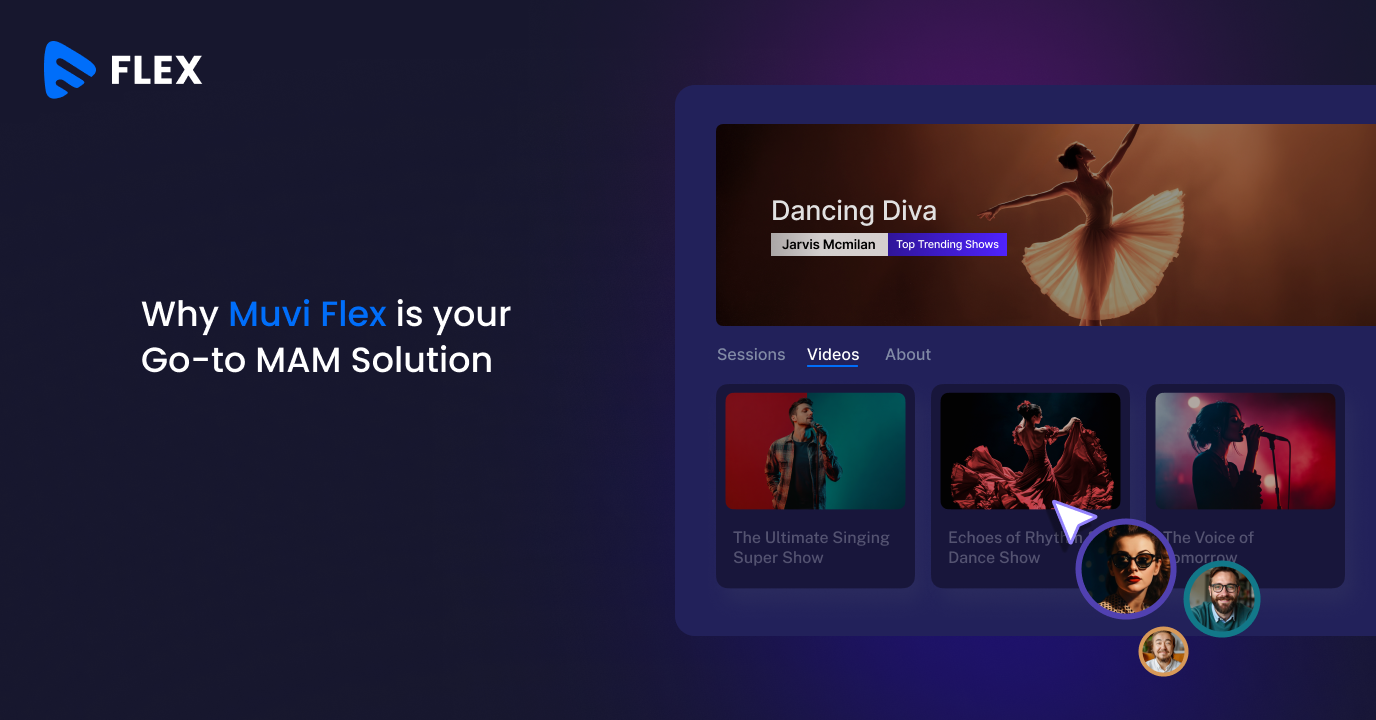As we embark upon the upcoming year of 2025, the demand for online video training platforms continue to grow at a rapid pace. This is largely because of the massive demand for online training across the globe. The global eLearning market is expected to reach $381.3 billion by 2026, with a CAGR of 17.7%. Amongst various types of eLearning, online video learning is creating quite a buzz and is expected to reach $58.2 billion by 2027, with a CAGR of 16.3%.
So, if you are looking to start your own online video training platform, then this is definitely the best time to get started. And we are here to help you out! In this blog, we will tell you everything you need to know to get started with your own video training platform. We will tell you why and how video training platforms are used, what features your platform must have, and the top video hosting platforms that you can use to develop your own video training platform in 2025. So, let’s get started!
Why Do You Need an Online Video Training Platform?
Online video training platforms offer multiple benefits, including:
- Engaging and Effective Learning: Humans are faster visual learners. Video training platforms combine audio, visuals, and sometimes even interactivity to create an engaging learning experience. This can lead to better information retention and understanding compared to text-based formats.
- Accessibility and Flexibility: Video training platforms offer learners the flexibility to access content anytime, anywhere, and at their own pace. Pair that with a communication app like slack, using slack apps, and you have incredible flexibility. This makes it ideal for busy individuals and those with diverse learning styles.
- Scalability and Cost-Effectiveness: Training platforms can cater to a large number of learners across different locations and time zones, at a single time. Hence, they are efficient and cost-effective for professional training delivered by organizations, compared to in-person training.
- Microlearning and Skill Development: Online videos can be broken down into short, digestible chunks. Hence, they are perfect for microlearning and focusing on specific skills needed for the job.
- Demonstrations and Simulations: Complex procedures, technical skills, or even soft skills like communication can be effectively demonstrated and practiced through video simulations.
- Varied Content Formats: Online training platforms offer a variety of content formats, including animations, expert interviews, screen recordings, and interactive quizzes, catering to different learning preferences.
Also, online training platforms are nowadays being used by different professionals across multiple industries for different learning use cases, like:
- HR Teams: HR professionals use online training platforms together with their HR software for onboarding new hires, delivering induction training, product-specific training, and process-specific training.
- Experienced Professionals: They use online training platforms for learning new software, developing industry-specific skills, compliance training, and soft skills development.
- Individuals: Anyone can use online training platforms for learning new hobbies, personal development courses, fitness programs, and language learning.
Top Features of Online Training Video Hosting Platforms
So when you start developing your own video training platform, there will be basically two ways to do so. The most preferred way is to build it using a ready-made online training platform builder, like Muvi One’s eLearning Module. In Muvi One’s eLearning module, you get every single feature you would ever need for your online training platform.

But in case you want to develop your front end from scratch, and use a third-party platform for hosting your training videos, you will have to find a suitable video hosting platform.
There are many video hosting platforms in the market that cater to video training use cases. So, how do you know which one is the best? It’s pretty simple, because the best platforms offer the most crucial features like DRM security, multi-format support, robust customer support, etc.
Let’s walk you through some of those most crucial features one by one.
Security
Multi-DRM security is the paramount feature that must be present in every online training platform. It helps in protecting sensitive learning materials and user data. It also helps prevent copyright infringement and illegal use of your learning videos.
There are multiple security features that online training platforms should offer, like:
- Encryption: Multi-DRM encryption helps securely store and transmit data to prevent unauthorized access to your videos.
- Screen-recording protection: Screen-recording lock helps prevent piracy of your learning videos, as the viewers cannot record them.
- Access controls: Good online training platforms let admins set user permissions to restrict access only to authorized individuals.
- Multi-factor authentication: Passwords and biometric verification add an extra layer of security for logins.
Multi-Format Support
It’s obvious that you would want to add different types of learning resources, including PDFs, Documents, audio files, and images, along with your videos. That is why your online training platform must have multi-format support. This allows you to add content in different formats.
24×7 Customer Support
Technical issues can disrupt learning. That is why, if you taking the help of a third-party video hosting platform, you must make sure that they offer 24×7 customer support. Round-the-clock support ensures quick solutions and minimizes downtime.
Playlists with HLS Output
The customized playlist feature lets you curate course-specific playlists, which help your learners quickly navigate through all the videos in a course. Also, HLS (HTTP Live Streaming) output helps you share those playlists as HLS links, which are easy to stream. HLS allows smooth playback on various devices and internet speeds.
Subtitle
Subtitles cater to diverse use cases. They can be of great help to audiences with hearing impairments, non-native speakers, and those in noisy environments. It also helps increase the lesson understanding and knowledge retention.
Multiple Encoding Profiles
Different devices and networks have varying bandwidth capacities. Encoding profiles offer optimized file sizes for different playback scenarios, ensuring smooth viewing across diverse environments.
Robust Analytics
Data insights are crucial for platform improvement and understanding user behavior. Also, Analytics help in tracking multiple important parameters, like:
- Video completion rates: By analyzing the video completion rates, you can gauge the engagement and effectiveness of your courses.
- User demographics and preferences: You can analyze demographics and audience preferences to deliver tailored content and target specific audiences.
By offering these features, your video training platform can provide a secure, accessible, and engaging learning experience to your learners. Hence, these platforms will become more effective and valuable learning tools for the users.
Top 12 Video Hosting Platforms for Online Training in 2025
So, now that you know which features to prioritize while creating your video training platform, it’s time to take a look at the top video hosting platforms that you can use in this process.
A lot of video hosting platforms offer some or all of the features we discussed above, but the platforms that we have listed are better than the rest. So, let’s walk you through them one by one.
1. Muvi Flex
Muvi Flex is a powerful platform for secure hosting and managing training videos. Its combination of features, security, and customization options makes it a strong choice for businesses and organizations of all sizes.
It helps you create video playlists, using which you can easily organize your training content into logical structures for easy navigation. You can also embed quizzes to check learners’ understanding.
Features
- Multi-format support
- Multi-DRM security
- Dynamic Watermarking
- Built-in CDN
- Bulk Upload
- Ad-based monetization
- HTML5 Video Player
- Playlists with HLS Output
- Social Publishing
- Advanced Analytics
Pros
- Centralized storage and management: Upload and organize all your training videos in one secure platform.
- Multiple delivery options: Share videos through secure links, embed them on your website or LMS, or publish them in your branded video portal.
- Customization: Customize your video player to match your training program’s look and feel.
- Security features: Control access to videos with password protection, user roles, and DRM encryption.
- Analytics: Track video views, completion rates, and engagement metrics to improve your training content.
- Integrations: Integrate with Learning Management Systems (LMS) and other tools for a seamless learning experience.
Cons
Pricing starts at $199/month, which might be higher than some other hosting platforms.
Pricing
Muvi Flex currently offers three pricing options:
- Their Standard plan starts at US $199 per month.
- You need to pay US $899 per month for their professional plan.
- Their Enterprise plan will cost you US $2899 per month.
Try Muvi Flex FREE for 14 days! Click Here to start Free Trial. No Credit Card Required!
2. Kaltura
Kaltura is a comprehensive video platform with robust features designed to support various training needs. Its strong LMS integration, feature richness, and scalability make it suitable for organizations of all sizes. However, the pricing structure and initial setup complexity might be tricky.
Features
- Video Quiz
- Video Capture
- Video Editing tools
- Powtoon
- Annoto
- Reach
Pros
- Learning Management System (LMS) Integrations: Kaltura integrates seamlessly with various LMS platforms, such as Moodle, Canvas, and Blackboard, streamlining content delivery within your existing learning environment.
- Comprehensive Feature Set: Offers a wide range of functionalities beyond basic video hosting, including lecture capture, live streaming, interactive video quizzes, video editing tools, and analytics.
- Security and Compliance: Provides robust security features like encryption, access control, and DRM, complying with industry standards for data protection.
- Scalability: Highly scalable solution suitable for organizations of all sizes, from small businesses to large enterprises.
- Flexible Deployment Options: Cloud-based, on-premise, or hybrid deployment options are available to accommodate specific needs.
- Engagement Boosters: Features like interactive video quizzes, polls, and annotations facilitate active learning and improve knowledge retention.
Cons
- Pricing plans can be complex and vary depending on your specific needs and chosen features.
- Compared to some platforms, Kaltura might have a steeper learning curve due to its extensive feature set.
- The level of customization options may not be as extensive as dedicated video hosting platforms like Muvi Flex.
Pricing
Kaltura offers three pricing options for their Virtual Classroom product:
- Their Standard plan starts at US $19 per month.
- Their Pro plan starts at US $45 per month.
- In case you need some other features, then you need to go with the Enterprise plan which comes with a custom pricing option.
3. Wistia
Wistia focuses on marketing and engagement, detailed analytics, and a user-friendly platform. That is why it is suitable for those aiming to capture leads, track progress, and offer interactive learning experiences. However, a limited free plan might require you to purchase plans with higher pricing options.
Features
- Customizable Player
- Video Galleries
- Easy Embedding
- Completely Ad-Free
- Easy Import, Organize, and Search
- Password Protection
- Interactive Videos
- Captions and Transcripts
- Compliance Tracking
Pros
- Focus on Marketing and Engagement: Wistia offers built-in marketing tools, facilitating lead generation and engagement for your training content. Features like Turnstiles (pop-up forms requiring email for viewing), CTAs, and email integration are valuable for capturing learner information and nurturing leads.
- Analytics and Tracking: Wistia provides detailed analytics on video engagement, including watch time, completion rates, and viewer behavior. This data allows you to optimize your training content for better effectiveness.
- Customization and Branding: Customize the video player and integrate it seamlessly with your website or training portal, maintaining a consistent brand experience.
- Security and Privacy: Wistia prioritizes security with password protection, access controls, and GDPR compliance.
- Ease of Use: The platform is known for its user-friendly interface, making it easy to upload, manage, and share videos.
Cons
- While Wistia offers a free plan, it has limitations on storage and features. Paid plans start at $19/month, which might be high for smaller training programs.
- Unlike Kaltura, Wistia doesn’t offer live streaming capabilities.
- While LMS integration exists, it’s not as extensive as Kaltura’s, potentially requiring additional development effort.
Pricing
Wistia offers three pricing options:
- Their plus plan starts at US $19 per month.
- You need to pay US $79 per month for their pro plans.
- Their Advanced plan will cost you US $319 per month.
4. VdoCipher
VdoCipher excels in video security and content protection. Hence, it is ideal for training platforms requiring strict access control and privacy measures. It’s developer-friendly tools and global reach help expand your business by adding new features quickly. However, it offers limited marketing features, with limited options for monetization or lead generation.
Features
- DRM Protection
- Dynamic Watermarking
- Easy Upload
- Built-in CDN
- Video API
- Custom Player Controls
- Disable Screen Capture
- Player API
- Domain Restriction
Pros
- Good Security Features: VdoCipher offers DRM encryption, dynamic watermarking, and screen capture blocking, effectively preventing unauthorized downloads or sharing of your training content.
- Compliance and Privacy: VdoCipher prioritizes data protection, complying with GDPR and other privacy regulations, making it suitable for sensitive training materials.
- Global Reach: VdoCipher’s global CDN ensures smooth video playback for learners worldwide, regardless of their location.
- Developer-Friendly: VdoCipher offers robust APIs and SDKs, allowing developers to deeply integrate video functionalities within their existing platforms or learning management systems.
- Detailed Analytics: Provides insights into video engagement, allowing you to track learner progress and optimize your training content.
Cons
- VdoCipher pricing might be higher compared to some general-purpose video hosting platforms, especially for smaller-scale training programs.
- VdoCipher primarily focuses on security and lacks built-in marketing tools like lead capture or CTAs.
- Customization options might be less extensive as compared to dedicated video hosting platforms like Muvi Flex.
Pricing
VdoCipher offers the following pricing options:
- Their starter plan starts at US $149 per year.
- Their value plan starts at US $399 per year.
- For their Pro plan, you need to pay US $1399 per year.
- Their Premium plan will cost you US $4999 per year.
5. Dacast
Dacast’s scalability, security, and user-friendly platform make it a solid choice for organizations hosting various training videos. Its CDN support and analytics capabilities are quite useful too. However, it offers limited marketing features compared to more training-specific platforms.
Feature
- Video CMS
- Video Transcoding
- Mobile Video Hosting
- Direct S3 Upload
- Immersive Video Gallery
Pros
- Scalability and Versatility: Dacast scales seamlessly as your training program grows, accommodating various needs and content volumes. It supports both live streaming and on-demand video hosting.
- Security and Compliance: Offers robust security features like password protection, access controls, and DRM encryption, ensuring the safety of your training materials.
- Multi-CDN Support: Dacast utilizes multiple Content Delivery Networks (CDNs) to ensure optimal video playback performance and global reach for your learners.
- Ease of Use: The platform is known for its user-friendly interface, making it simple to upload, manage, and share training videos.
- Analytics and Reporting: It provides detailed analytics on video engagement, including watch time, completion rates, and demographics, aiding in improving your training content.
Cons
- While Dacast offers a free plan, it has limitations on storage and features.
- Unlike some platforms, Dacast doesn’t currently offer native offline viewing functionality.
- Built-in marketing tools like lead capture forms or CTAs are not as extensive as in some dedicated training platforms.
Pricing
Dacast offers multiple pricing models, including:
- Starter plan that costs US $39 per month.
- Event plan that costs US $63 per month.
- Scale plan, that costs US $165 per month.
6. Panopto
Panopto is a leading video platform specifically designed for education and enterprise training. It offers a comprehensive suite of features designed to enhance learning outcomes. Its powerful search, seamless LMS integration, and engagement tools make it a valuable asset for creating effective training programs. However, customization limitations and fewer marketing features are downsides.
Features
- Video Management
- Video Search & Discovery
- Integration with LMS
- Lecture Capture
- Accessibility and Compliance
Pros
- Built for Education & Training: Panopto offers features specifically tailored for training environments, including lecture capture, live streaming, searchable video libraries, and quizzing capabilities.
- Smart Search and Indexing: Its AI-powered search engine allows learners to easily find specific information within your training videos by keyword, speaker, or timestamp, enhancing knowledge retention.
- Scalability and Security: Panopto caters to organizations of all sizes, with robust security features like encryption, access controls, and user roles to protect your training content.
- Seamless LMS Integration: Integrates seamlessly with various Learning Management Systems (LMS) like Canvas, Blackboard, and Moodle, streamlining content delivery and progress tracking.
- Engagement Tools: Interactive features like annotations, polls, and discussions within videos promote learner engagement and active learning.
- Screen Recording and Editing: It offers built-in tools for screen recording and basic video editing, enabling easy creation of training content.
Cons
- Customization options might be less extensive compared to dedicated video hosting platforms like Muvi Flex.
- Built-in marketing tools like lead capture forms or CTAs are not as extensive as in some dedicated training platforms.
Pricing
Patopto offers customized pricing for your specific needs. So, connect with them to know about their pricing structure.
7. Cincopa
Cincopa excels in engagement features, branding options, and marketing tools. They also help track viewer behavior and create an interactive learning experience. However, they have a limited free plan, a lack of live streaming, and potentially less advanced security features compared to other options.
Features
- Video Analytics
- Bulk Uploading
- Encryption
- Marketing Automation
- Unlimited Embedding
- Video Heatmaps
Pros
- Engagement Features: Offers interactive video quizzes, polls, lead capture forms, and CTAs within videos, fostering learner engagement and collecting valuable data.
- Analytics and Reporting: Provides insights into video viewing behavior, quiz results, and lead capture data, helping you improve your training content and track outcomes.
- Branding and Customization: Customize the video player and portal to match your training program’s branding, creating a consistent experience.
- Security and Compliance: Offers password protection, access controls, and GDPR compliance to ensure secure video delivery.
- Multiple Delivery Options: Share videos through secure links, embed them on your website or LMS, or publish them as a branded video portal.
Cons
- Cincopa offers a free plan with limited features and storage.
- Unlike some platforms, Cincopa doesn’t offer live streaming capabilities.
- While offering essential security features, security in Cincopa might not be as robust as platforms specializing in secure video hosting like Muvi Flex.
Pricing
Cincopa offers the following pricing plans:
- Their Plus plan starts from US $25 per month.
- You need to pay US $99 per month for their corporate plan.
- Their enterprise plan will cost you US $350 per month.
8. Vimeo
Vimeo offers high-quality video hosting, ad-free viewing, and basic features suitable for some training needs. However, its limited storage and fewer engagement features compared to dedicated training platforms might be drawbacks.
Features
- AI Script Generator
- Online Teleprompter
- Webinar Solution
- Video Editing Solution
- Interactive Features
Pros
- High-quality video hosting: Vimeo is renowned for its commitment to high-quality video playback, ensuring a professional and engaging learning experience.
- Ad-free viewing: Unlike YouTube, Vimeo offers ad-free viewing, preventing distractions and enhancing focus for learners.
- Privacy options: You can choose private or password-protected video settings, ensuring only authorized viewers access your training content.
- Branding and customization: Customize the video player with your logo and branding colors for a consistent learning experience.
- Analytics and insights: Track video views, completion rates, and engagement metrics to understand how your training content is performing.
- Integrations: Vimeo integrates with various tools like Zapier and Wistia, offering some flexibility for workflow integration.
Cons
- Limited storage and bandwidth: Free plans come with limited storage and bandwidth, potentially insufficient for extensive training video libraries.
- No live streaming: Vimeo doesn’t offer live streaming capabilities, which might be crucial for certain training scenarios.
- Limited engagement features: While offering basic analytics, Vimeo lacks interactive features like quizzes or lead capture forms compared to dedicated training platforms.
- Higher pricing for advanced features: Upgrading to higher plans for increased storage, bandwidth, and advanced features can be expensive compared to some competitors.
Pricing
Vimeo offers the following pricing plans:
- Its starter plan starts at US $20 per month.
- You need to pay US $33 per month for its Standard plan.
- Its Advanced plan will cost you US $108 per month.
9. Brightcove
Brightcove excels in its powerful features, scalability, and security, making it suitable for large organizations or training programs requiring advanced functionalities. However, its steeper learning curve and higher pricing might be drawbacks for smaller or simpler training needs.
Features
- Ad Monetization
- Audience Insights
- Zencoder
- Marketing Studio
Pros
- Enterprise-level Scalability: Brightcove caters to large organizations and scales seamlessly to accommodate extensive video libraries and high traffic volumes.
- Live Streaming and VOD: Supports both live streaming events and on-demand video hosting, offering flexibility for diverse training formats.
- Security and Compliance: Provides robust security features like encryption, access controls, and DRM, ensuring the safety of your confidential training content.
- Advanced Analytics and Reporting: Offers detailed analytics on video engagement, viewer demographics, and completion rates, providing valuable insights for improving your training content.
- Customization and Branding: Customize the video player and experience to match your training program’s branding, creating a consistent and professional look.
- Integrations: Integrates with various Learning Management Systems (LMS) and other tools, streamlining content delivery and workflow.
Cons
- Steeper Learning Curve: Brightcove’s wide range of features and functionalities might require a steeper learning curve compared to simpler platforms.
- Higher Pricing: Brightcove’s pricing plans are generally higher than many competitors, potentially unsuitable for smaller training programs.
- Complexity for Simpler Needs: If your training program has basic video hosting needs without requiring live streaming, advanced analytics, or extensive customization, a simpler platform might be more cost-effective.
Pricing
You need to talk to their sales team to know about their pricing structure.
10. YouTube
You can certainly choose YouTube as an option for hosting your training videos, but there are both advantages and disadvantages to consider. While YouTube offers ease of use and potentially large reach, its limitations in customization, ad presence, and engagement features might not be ideal for professional training environments.
Pros
- Free to use: YouTube offers a free plan with a generous storage limit and bandwidth allowance, making it a budget-friendly option.
- Large audience: With billions of users, YouTube provides you with a platform to reach a wide audience, depending on your target demographic.
- Easy to use: Uploading and sharing videos on YouTube is relatively straightforward, with a user-friendly interface.
- Mobile accessibility: Learners can access your training videos on the go through the YouTube app on various devices.
- Basic analytics: YouTube provides basic analytics on video views, likes, and comments, allowing you to gauge engagement.
Cons
- Limited customization: You have limited control over the player’s appearance and branding, potentially affecting the professional presentation of your training content.
- Ads: Free versions of YouTube display ads before and during videos, which can be disruptive to learning.
- Privacy concerns: Public videos on YouTube are searchable and accessible to anyone, potentially raising privacy concerns for confidential training materials.
- Limited engagement features: YouTube lacks interactive features like quizzes or lead capture forms, making it less engaging for certain training needs.
- Monetization challenges: Monetizing your training content through YouTube requires enabling ads, potentially disrupting the viewing experience.
11. Hippo Video
Hippo Video’s focus on training, ease of use, interactive features, and integrations make it a strong contender for hosting your training videos. However, it offers a limited free plan and a steep learning curve for beginners.
Features
- Teleprompter
- Video Flows
- Analytics
- Basic Editing
- User Roles and Permissions
Pros
- Focus on Training and Education: Hippo Video is specifically designed for creating and sharing training videos, offering features tailored to educational needs.
- Easy Video Creation: Offers screen recording, webcam recording, and video editing tools within the platform, simplifying content creation.
- Interactive Features: Embed quizzes, polls, and annotations within videos to boost learner engagement and knowledge retention.
- Branding and Customization: Customize the video player and portal to match your training program’s branding, creating a consistent experience.
- Security and Compliance: Provides password protection, access controls, and GDPR compliance to ensure safe video delivery.
- Analytics and Reporting: Track video views, completion rates, quiz results, and user engagement data to understand content effectiveness.
- Integrations: Integrates with various Learning Management Systems (LMS) like Moodle, Canvas, Personalised Canvas Prints and Blackboard, streamlining workflow.
Cons
- The free plan has limited features and storage space, potentially requiring an upgrade for extensive training programs.
- While user-friendly, some advanced features might require more exploration for beginners.
Pricing
Hippo Video charges you on a per-user per-month basis:
- In their Pro plan, you need to pay US $20 per user per month.
- Their Teams plan will cost you US $60 per user per month.
- You will need to pay US $80 per user per month for their Enterprise plan.
12. UScreen
Uscreen specifically caters to creators and businesses aiming to build their video membership platforms. Its easy platform creation, flexible monetization options, and engagement features make it valuable for various training needs.
Features
- Video CMS
- Monetization
- Analytics
- Integrations
- Video Player
- Custom Playlists
- Password Protection
Pros
- Focus on Video Membership Platforms: UScreen is built specifically for creating and managing subscription-based video platforms, offering features tailored to memberships and training delivery.
- Easy Platform Creation: Launch your own branded video platform quickly and easily, without coding knowledge required.
- Content Organization: Structure your training videos into logical categories, playlists, and courses for organized learning experiences.
- Monetization Flexibility: Offer various pricing models like subscriptions, pay-per-view, and rentals, adapting to different training needs.
- Marketing and Promotion Tools: Utilize built-in marketing tools like email marketing, coupons, and promotions to attract and retain learners.
- Engagement Features: Implement quizzes, discussions, and community features to boost learner engagement and interaction.
- Analytics and Reporting: Track learner progress, completion rates, and revenue metrics to monitor your training program’s performance.
- Mobile App Support: Offer learners a convenient way to access training videos on mobile devices through your branded app.
Cons
- It is an expensive platform.
- While offering basic security features, UScreen might not be as robust as platforms specifically designed for secure video hosting.
- The free plan has limited features and storage space, potentially requiring an upgrade for extensive training programs.
Pricing
Uscreen offers the following pricing options:
- Its growth plan will cost you US $199 per month.
- You will have to pay US $599 per month for their Pro plan.
To Sum Up
Online video training is growing in popularity. So, it is the perfect time to develop your own video training platform. You can definitely use Muvi One’s eLearning Module to develop your own customized video training platform, without any coding, from scratch.
Muvi One eLearning Module comes with 500+ industry-leading features, including:
- Learner and Admin Management
- Assessment and Evaluation
- Multi-Format Support
- Multiple Monetization Options
- Multi-DRM Security
- Course Recommendation
- Multi-lingual Support
And many more…
Try Muvi One eLearning FREE for 14 days! Click Here to start Free Trial. No Credit Card Required!
And if you are looking for a third-party video hosting platform, then you can choose from the top video training hosting platforms discussed in this blog.
Amongst the video training hosting platforms discussed so far, Muvi Flex clearly stands out due to its robust all-around features. And getting started with Muvi Flex is easier than you think! You just need to sign up with your basic information, and you can then Try Muvi Flex for FREE for 14 days! No credit card is required. So why wait? Sign up to start your 14-day free trial today!


















Add your comment